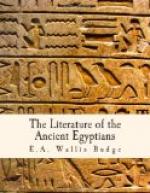Pursue thy heart’s desire and thine own happiness.
Order thy surroundings on earth in such a way
That they may minister to the desire of thy heart;
[For] at length that day of lamentation shall come,
Wherein he whose heart is still shall not hear the
lamentation.
Never shall cries of grief cause
To beat [again] the heart of a man who is in the grave.
Therefore occupy thyself with thy pleasure daily,
And never cease to enjoy thyself.
Behold, a man is not permitted
To carry his possessions away with him.
Behold, there never was any one who, having departed,
Was able to come back again.
[Footnote 1: He was one of the kings of the eleventh dynasty, about 2700 B.C.]
[Footnote 2: A high official of Tcheser, a king of the third dynasty.]
[Footnote 3: Son of Khufu, the builder of the Great Pyramid (fourth dynasty.)]
CHAPTER XV
MISCELLANEOUS LITERATURE
In this chapter are given short notices of a series of works which the limits of this book make it impossible to describe at greater length.
I. The BOOK OF THE TWO WAYS.—This is a very ancient funerary work, which is found written in cursive hieroglyphs upon coffins of the eleventh and twelfth dynasties, of which many fine examples are to be seen in the British Museum. The object of the work is to provide the souls of the dead with a guide that will enable them, when they leave this world, to make a successful journey across the Tuat, i.e. the Other World or Dead Land, to the region where Osiris lived and ruled over the blessed dead. The work describes the roads that must be travelled over, and names the places where opposition is to be expected, and supplies the deceased with the words of power which he is to utter when in difficulties. The abode of the blessed dead could be reached either by water or by land, and the book affords the information necessary for journeying thither by either route. The sections of the book are often accompanied by coloured vignettes, which illustrate them, and serve as maps of the various regions of the Other World, and describe the exact positions of the streams and canals that have to be crossed, and the Islands of the Blest, and the awful country of blazing fire and boiling water in which the bodies, souls, and spirits of the wicked were destroyed.
II. The BOOK “AM TUAT,” or Guide to him that is in the Tuat.—This Book has much in common with the Book of the Two Ways. According to it, the region that lay between this world and the realm of Osiris was divided into ten parts, which were traversed, once each night, by the Sun-god in the form which he took during the night. At the western end was a sort of vestibule, through which the god passed from the day sky into the Tuat, and at the eastern end was another vestibule, through which he passed on leaving the Tuat to re-enter the




